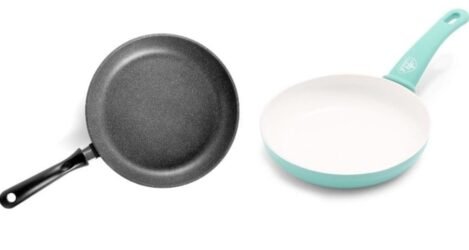Shopping for kitchen appliances can take a great deal of time, effort and trial-and-error – a lot more than many people realize, in fact! Whether you’re a master chef or an amateur cook, it’s important to invest in supplies, appliances and cookware that will not only meet your needs, but stand the test of time (and extensive heat and scraping).
If you’ve done your research or asked around a bit, you’ve probably already heard a few key buzzwords about the best types of appliances to buy—ceramic non-stick pans, air fryers, Ninja blenders, the list goes on. With so many exciting, versatile appliances on the market, it can be hard to determine which ones are worthy of your investment and which aren’t going to last you long enough to get your money’s worth.
Two of the most popular materials for pans and other kitchen appliances are ceramic and Teflon. Both are easy to work with, versatile and can withstand a great deal of use without getting damaged. So what’s the best choice for you? And how much of a difference is there between the two?
Ceramic Cookware Pro: It Is Better for Your Body (and the Environment)
You may be asking yourself, “how can a kitchen gadget have any sort of impact on my body or my immediate environment?” The truth is, just as you pay attention to the chemicals you’re ingesting through your food, you should also be paying attention to the chemicals used to cook the food.
One of the reasons people choose ceramic cookware, like ceramic non-stick pans, over teflon is because ceramics are free from chemicals like lead, cadmium, PFOAs and other potentially toxic chemicals or heavy metals. A variety of cooking supplies are made with these heavy metals, so ceramics are one of the safest choices. Investing in a good set of ceramic non-stick pans and pots will go a long way in keeping you and your environment safe.
Ceramic Pro: It Evenly Distributes Heat and Can Be Used in the Oven
If your recipes often involve multiple pots and pans, you know how exciting it can be to eliminate even one piece of cookware from your dishwashing lineup at the end of the meal. Ceramics are built to withstand the oven, meaning you can stick it in there to keep it warm or even do most of the cooking in the ceramic pan itself. It’s also built to withstand the broiler.
In addition to being oven-safe, ceramic cookware also evenly distributes heat. Nothing is more annoying than trying to cook your meal and having to push all the ingredients toward the middle because the edges aren’t getting hot enough. Gone are those days with a handy ceramic pan!
Ceramic Con: Its Cooking Performance Can Be Inconsistent
In spite of all of its winning qualities, amateur and professional chefs alike have occasionally pointed to the inconsistent nature of the performance of ceramic cookware. This is especially true for people who already cook consistently with other types of cookware and are making the switch to ceramic. You may find that there is a bit of a learning curve and a need to adjust current routines and recipes to fit the unique performance of your new ceramic cookware. Read more about Taco bell potato soft taco.
Teflon Pro: You Don’t Need to Use Oil With It
As hard as it may be to believe, Teflon is such a champion in the non-stick cookware game that you don’t need to use any oils when cooking on it. Ceramics are known for requiring less oil as well, but teflon is more widely known for this.
This not only makes cooking easier (and potentially less dangerous, since it helps you avoid those pesky oil pops), it can also help you cut calories and lose weight by eliminating the extra oils in your meal.
Teflon Con: Doesn’t Hold Up as Well
In spite of that, Teflon cookware is, unfortunately, known to lose its non-stick properties much more quickly than ceramic non-stick pans or other ceramic cookware.
Even more amazing is the fact that in spite of not requiring oils, the coating on teflon cookware is extremely resistant to scratches and other damage that most cooking utensils can inflict on your cookware over time.
That being said, it’s important to note that teflon is definitely damaged by metal cooking utensils, though this is the case for most kinds of cookware.
So, What’s the Winner?
Though ceramic cookware is typically more of an upfront investment, the benefits of it outweigh the benefits and uses of Teflon cookware.
Though Teflon provides a number of time-saving, convenient and helpful benefits, the fact that it can release chemicals that are toxic to your body and can even cause what’s known as “The Teflon Flu” makes it a clear second to the toxin-free material of ceramic.
If you’re ready to make the jump into ceramic cookware, you’re in luck – nowadays, there are so many manufacturers that make ceramic cookware in a variety of fun colors and versatile uses that can help you significantly cut down on the amount of cookware you keep around your kitchen at all.




 The Benefits of Having Large Instagram Followers
The Benefits of Having Large Instagram Followers